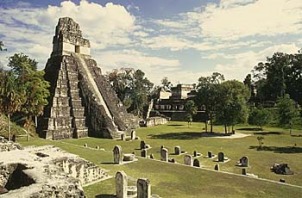Mayan Economy and Society

Maya population was in general very small, and very few of the Mayas permanently lived in the urban centers. The central reason for this is the nature of agriculture in tropical rain forest. The Mayas, like others forced to cultivate tropical rain forest, practiced slash and burn agriculture. Because growth is so rapid in tropical rain forests, the nutrients provided by dead plants and animal feces gets used up very quickly. Rain forest soil, surprisingly, is remarkably unfertile for agriculture. In slash and burn agriculture, the Mayans would cut down a swath of forest, burn the felled trees and plants for fertilizer, and then cultivate the plot. Now as then the Mayans did not employ sophisticated fertilization techniques, so the plot of land would be exhausted in two to four years (some archaeologists estimate that it may have taken as long as seven years if the Mayans weeded by hand rather than using tools). What all this means is that it takes an immense amount of land to support a family—among the Maya, it probably required at least seventy acres for every five people. The population, then, throughout the Classic Period was very small.
Slash and burn agriculture (called milpa by the Mayas) is also labor intensive. Modern-day Native Americans in Guatemala who employ this agriculture spend about 190 days every year in agricultural work. Despite this labor, you can see that at least 170 days are left over (almost half of a year) for other types of labor. This excess time was used in the Classic Period in the building and maintenance of cities as well as the extensive production of art-work and the agricultural labor necessary to support the priestly populations in the cities.
The principal food of the Mayas was maize and maize production was the central economic activity of the Mayas. Milpa farming itself, which is dependent on a holistic view of one's activities since the cultivated plot keeps moving, seems to have been the foundational basis of the Mayan religion and the Mayan concern with time.
We know almost nothing of Mayan society beyond the social division between the priests and the peasants. Mayan society had several strata: rulers, priests, commoners, and slaves. The extent to which the rulers were differentiated from the priests is unknown. At the top of the Mayan hierarchy was the halach uinic ("True Man"), whose position was hereditary. The halach uinic ruled both domestic and foreign affairs with the help of a council. Lesser chiefs ruled smaller social units.
In the religious hierarchy, the head was called Ah Kin Mai ("The Highest One of the Sun") who ruled over all the priests below him (called Ah Kin , "The One of the Sun"). There were two special priestly functions involved in human sacrifice: the chacs , who were elderly men who held down the victim, and the nacon , who cut the living heart from the victim.
Mayas had a sense of physical beauty very different from other peoples in Mesoamerica. They prized a long, backward sloping forehead; in order to attain this look, infants would have their skulls bound with boards. Crossed-eyes were an important item of physical beauty; infants would have objects dangled in front of their eyes in order to permanently cross their eyes (this is still practiced today).
